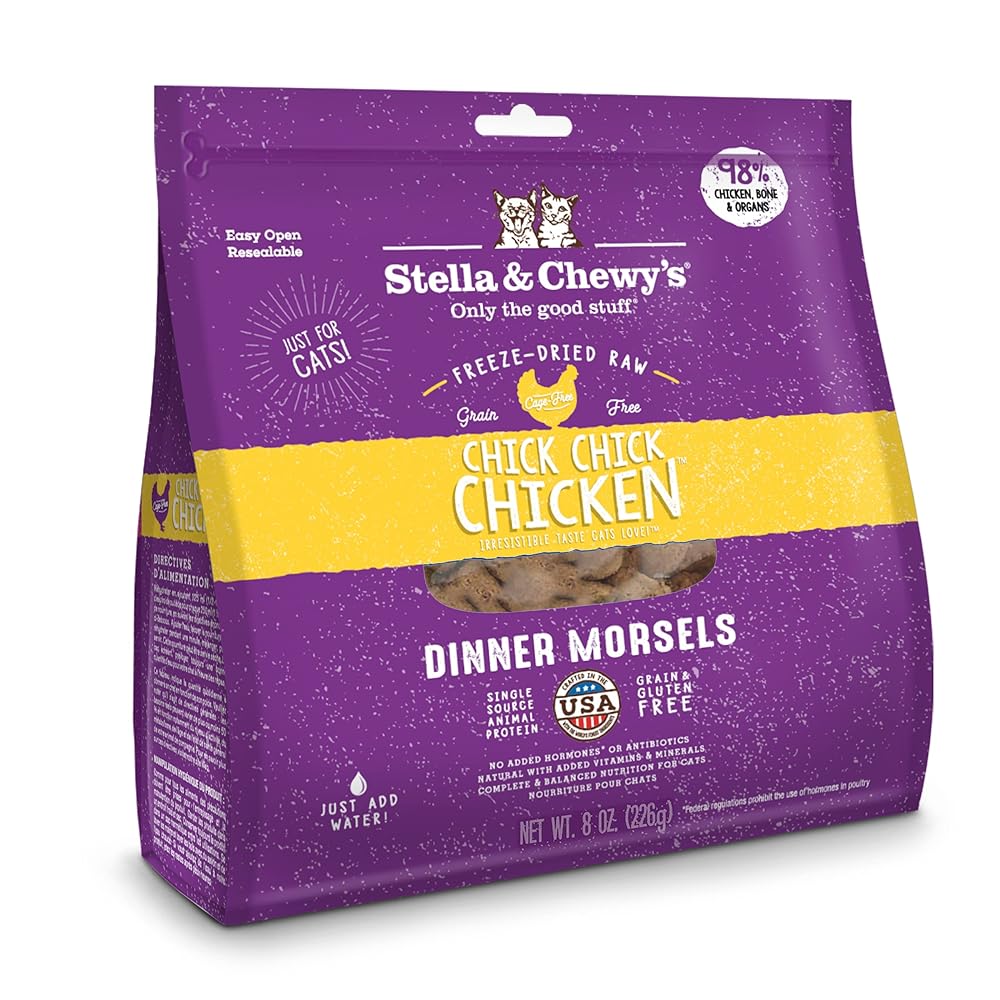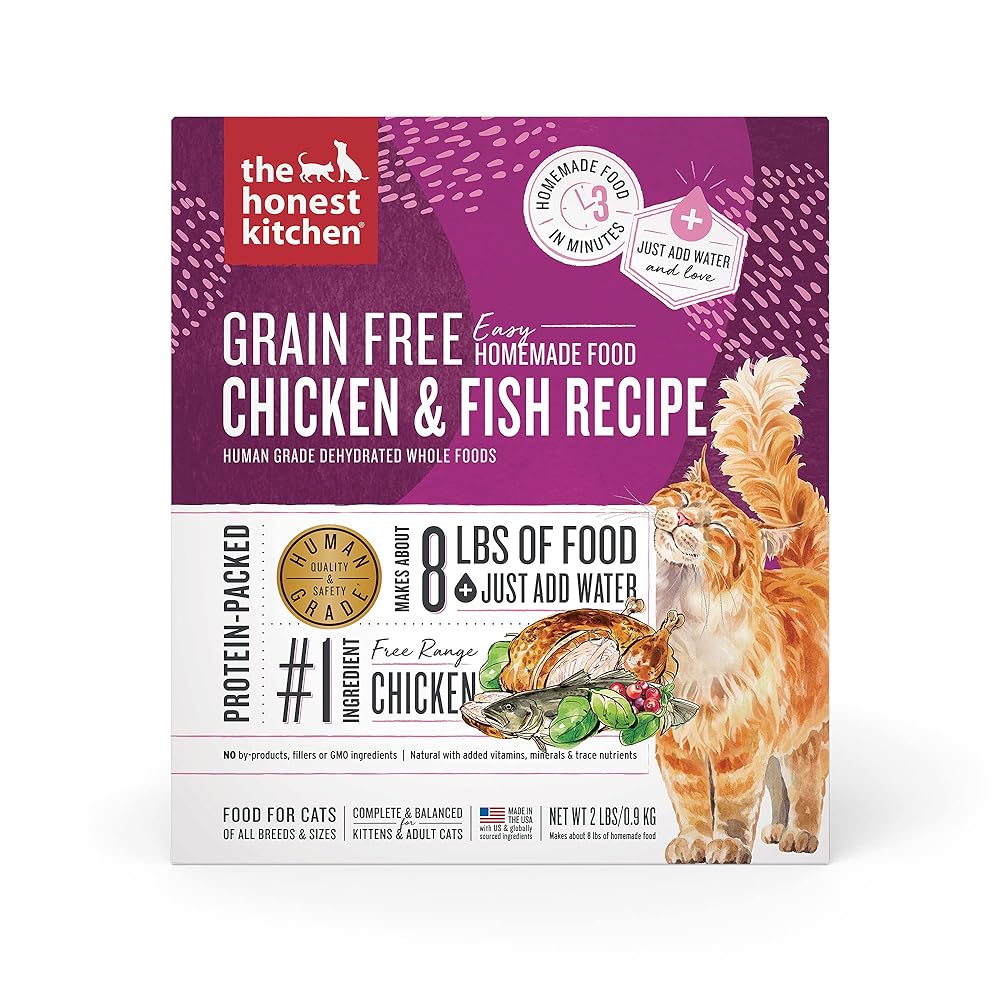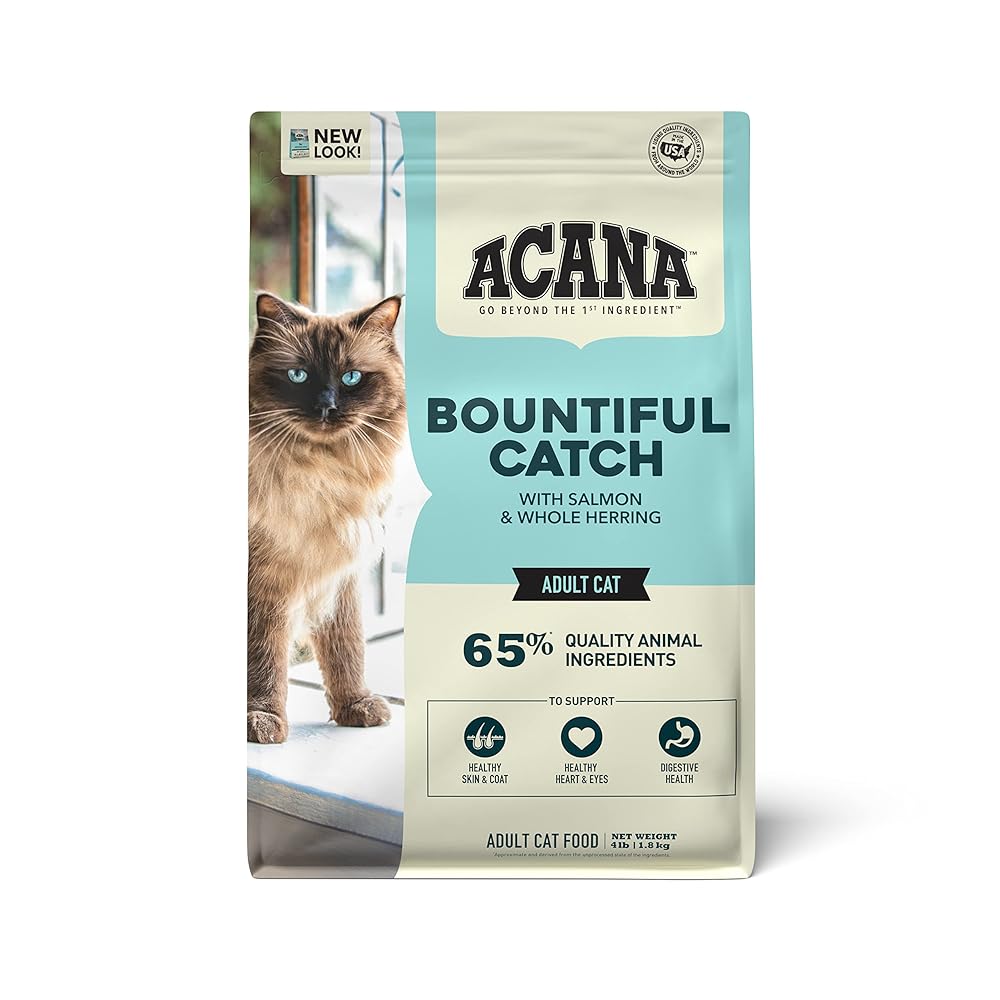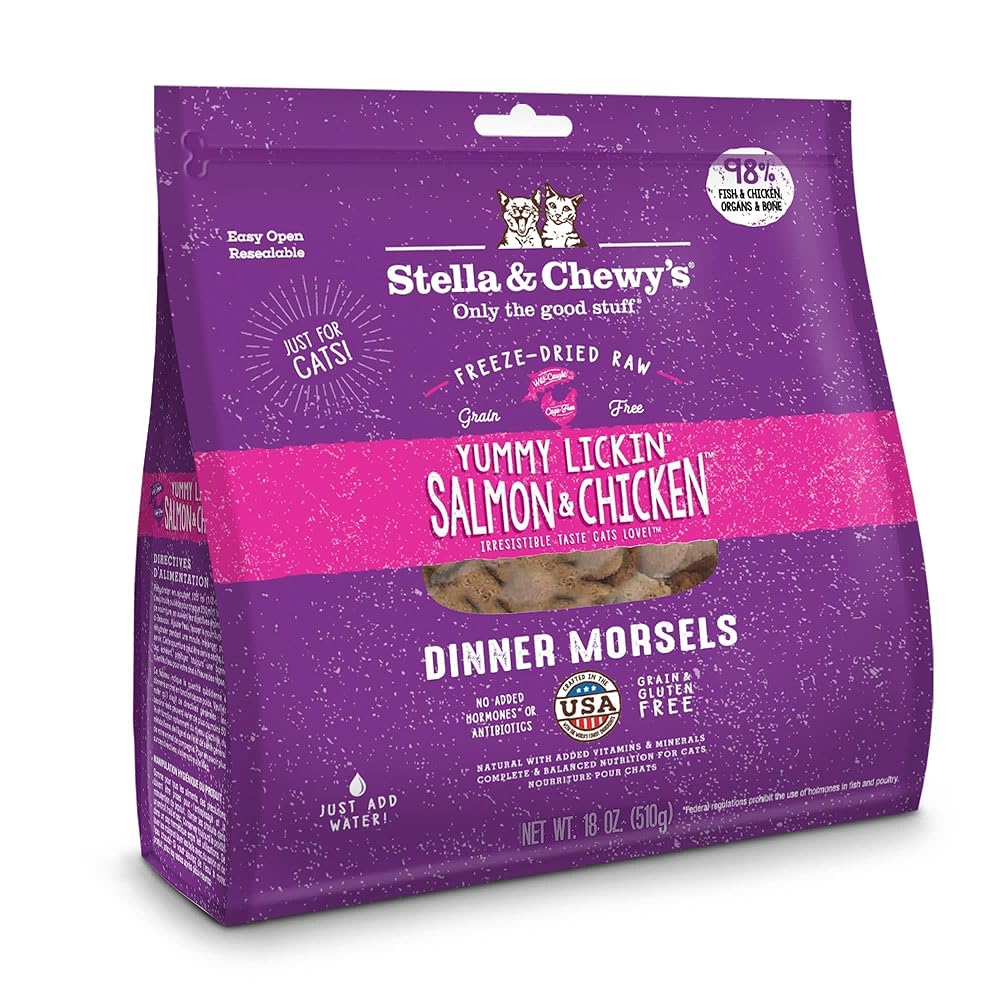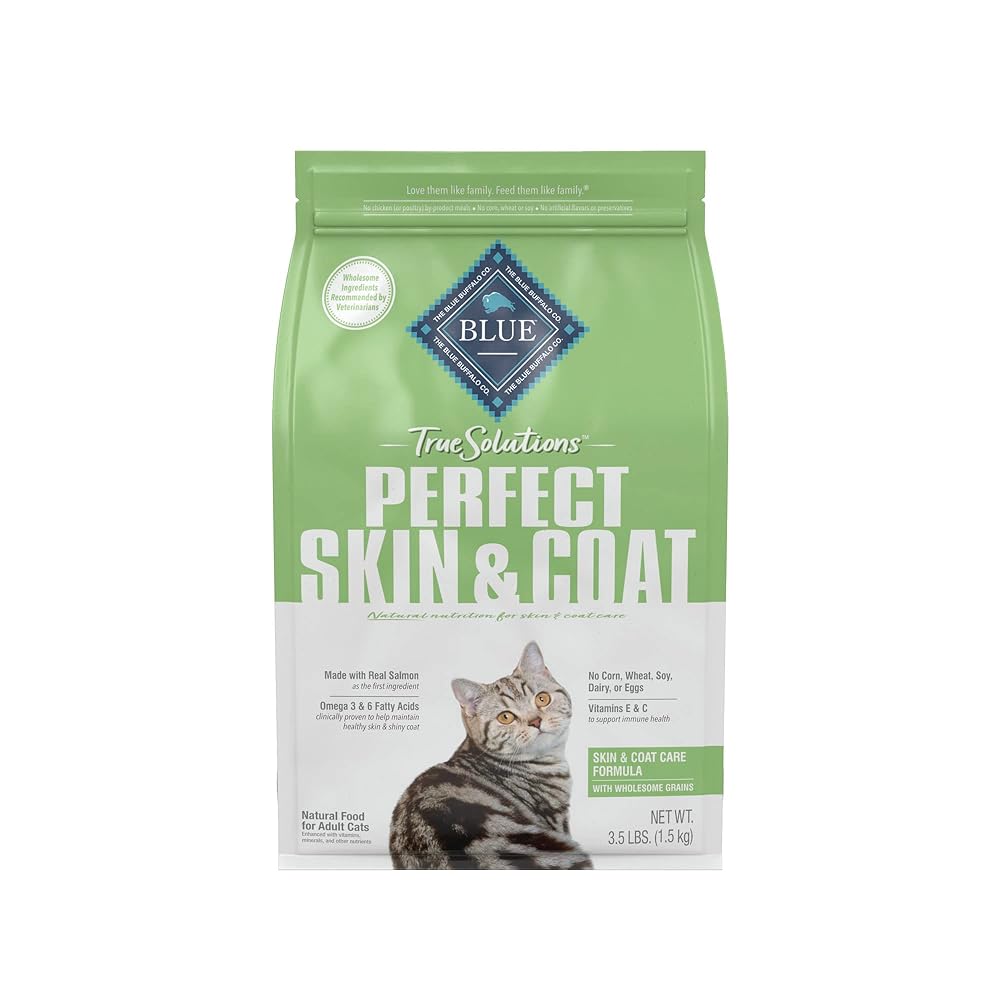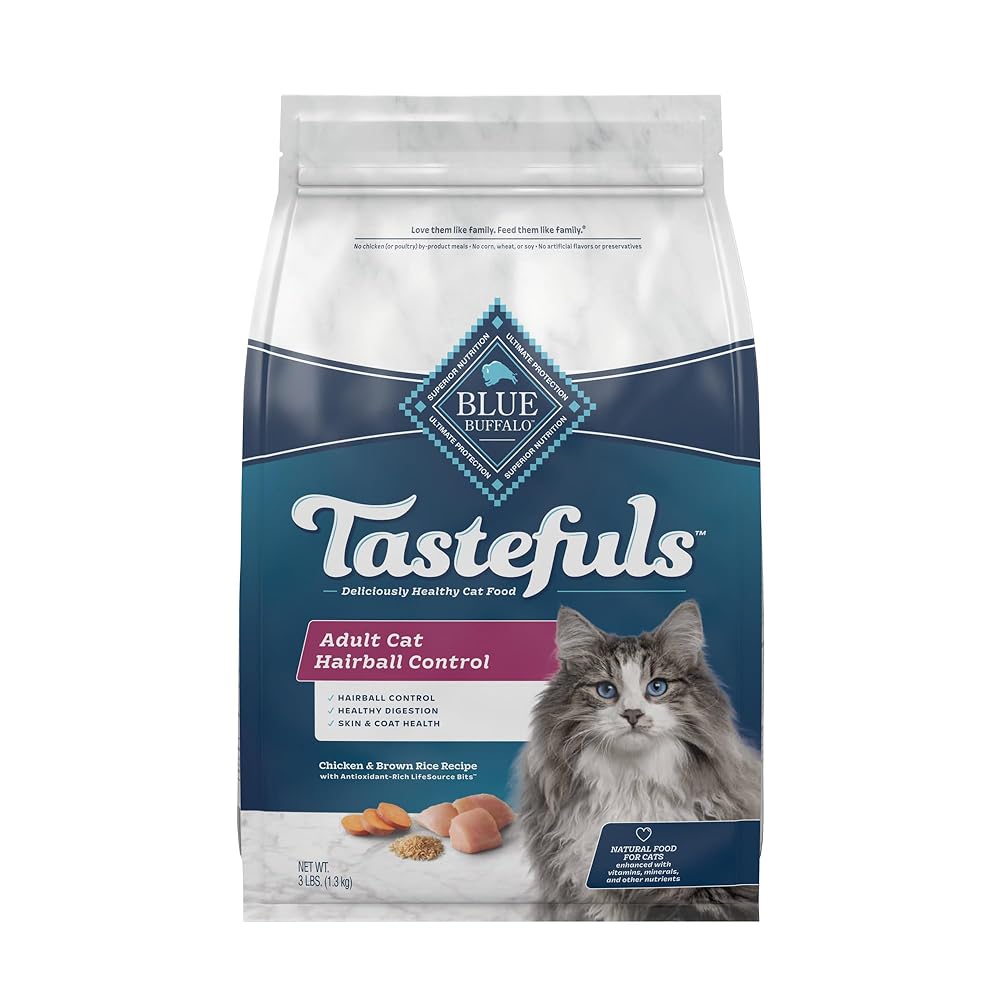Excessive shedding in cats can be a concern for many pet owners. While shedding is a natural process, excessive hair loss can sometimes indicate an underlying health issue or nutritional deficiency. One way to help manage excessive shedding is through your cat’s diet. This article will delve into the best cat foods for shedding, considering factors like omega fatty acid content, protein quality, and the inclusion of vital nutrients that promote a healthy coat and skin.
#1 – Stella & Chewy’s Freeze-Dried Raw Chick, Chick, Chicken Dinner Morsels Grain-Free Cat Food, 8 oz bag
Stella & Chewy’s Freeze-Dried Raw Chick, Chick, Chicken Dinner Morsels Grain-Free Cat Food is a protein-rich, nutrient-dense cat food made with responsibly sourced meats and no unnecessary fillers. It is designed to mimic a cat’s ancestral diet and support whole body health, including digestion, skin and coat, and immune function. This product is best for cats and kittens who prefer a raw diet and need support for allergies or overall wellness.
#2 – The Honest Kitchen Dehydrated Grain Free Chicken & Fish Cat Food, 2 lb Box
The Honest Kitchen Dehydrated Grain Free Chicken & Fish Cat Food is a high-quality cat food option made with real whole food ingredients. It contains two proteins – free-range chicken and wild-caught white fish – making it high in protein and delicious. This recipe is 100% human grade and made in the USA, ensuring the use of trusted sources and higher safety standards.
Best For: Cats of all life stages, breeds, and sizes.
#3 – ACANA Bountiful Catch Dry Cat Food for Adult Cats, Salmon and Whole Herring Recipe, Fish Cat Food, 4lb
ACANA Bountiful Catch Dry Cat Food is a high-quality cat food made with raw salmon and whole herring to provide a nutritionally balanced diet for adult cats. With 65% animal ingredients, it is rich in protein and also contains Omega-3 and Omega-6 fatty acids to support healthy skin, heart, and eyes. This cat food is made in the USA using quality ingredients sourced from around the world.
Best For: Cats looking for a nutrient-dense, high-protein diet.
#4 – Stella & Chewy’s Freeze-Dried Raw Cat Dinner Morsels – Grain Free, Protein Rich Cat & Kitten Food – Yummy Lickin’ Salmon & Chicken Recipe – 18 oz Bag
Stella & Chewy’s Freeze-Dried Raw Cat Dinner Morsels are a grain-free, protein-rich cat and kitten food. Made with real raw ingredients, these meals support healthy digestion, strong teeth and gums, vibrant skin and coat, and overall vitality. With a high percentage of fish, chicken, organs, and bone, these dinner morsels appeal to even the pickiest eaters.
Best for: Cats and kittens with allergies and picky eaters.
#5 – Blue Buffalo True Solutions Perfect Skin & Coat Natural Adult Dry Cat Food, Salmon 3.5-lb
The Blue Buffalo True Solutions Perfect Skin & Coat Natural Adult Dry Cat Food is a specially formulated dry cat food that helps to care for cats’ sensitive skin. It contains high-quality salmon, omega 3 and 6 fatty acids, and natural ingredients recommended by veterinarians. This cat food does not contain any chicken by-product meals, corn, wheat, soy, artificial flavors, or preservatives.
Best For: Cats with sensitive skin and coat. (best ingredient sourcing)
#6 – Blue Buffalo Tastefuls Hairball Control Natural Adult Dry Cat Food, Chicken, 3lb bag
Blue Buffalo Tastefuls Hairball Control Natural Adult Dry Cat Food is a specially formulated cat food designed to help with hairball control in indoor cats. Made with real chicken as the first ingredient, this food also contains psyllium seed husks and cellulose for hairball control, as well as natural fiber for healthy digestion and Omega 3 and 6 fatty acids for skin and coat health. It is made with wholesome ingredients and does not contain any chicken by-product meals, corn, wheat, soy, or artificial flavors or preservatives.
Best For: Hairball control in indoor cats.
#7 – Blue Buffalo Basics Skin & Stomach Care Grain Free, Natural Indoor Adult Dry Cat Food, Fish & Potato 11-lb
Blue Buffalo Basics Skin & Stomach Care Grain Free, Natural Indoor Adult Dry Cat Food is a limited-ingredient cat food that supports gentle digestion without gluten-containing grains. It is made with real whitefish, potatoes, and pumpkin, making it a good option for cats with sensitive stomachs. This formula also includes Blue’s exclusive LifeSource Bits, a precise blend of antioxidants, vitamins, and minerals that support immune system health. Best for: cats with food sensitivities or sensitive stomachs.

#8 – Alaskan Gold SUPER3+ (Salmon+Freeze Dried Raw Salmon+Salmon Fish Oil) Dry Cat Food | Kitten & Adult | High-Protein | Grain-Free | Allergy & Digestive Support| All-Natural | 3-lbs
Alaskan Gold SUPER3+ is a dry cat food that combines high-protein salmon kibble, freeze-dried raw salmon, and salmon oil, along with ocean super greens. It is designed to nourish overall health, support allergies, and sensitive stomachs, and promote healthy skin and coat. The recipe excludes cheap fillers and artificial ingredients. Best For Allergy & digestive support, overall health, and nutrient-dense nutrition.

What Should I Consider When Purchasing Cat Food to Reduce Shedding?
When purchasing cat food to reduce shedding, you’ll want to focus on a few key nutritional components that contribute to healthy skin and a shiny coat. Here are some factors to consider:
- High-Quality Protein: Protein is the building block of your cat’s skin and fur. Look for foods that contain high-quality animal-based proteins like chicken, fish, or turkey as the first ingredient.
- Omega Fatty Acids: Omega-3 and Omega-6 fatty acids are essential for maintaining skin health and reducing inflammation, which can lead to less shedding. Foods enriched with fish oil or flaxseed are often good sources.
- Vitamins and Minerals: Certain vitamins like A and E and minerals like zinc contribute to skin health. Ensure the cat food you choose is well-balanced and contains these essential nutrients.
- Avoid Fillers and Allergens: Cheap fillers like corn, wheat, and soy, as well as potential allergens like artificial colors and flavors, can exacerbate skin issues and therefore increase shedding. Look for foods that are free from these ingredients.
- Hydration: Wet foods can contribute to better hydration, which is beneficial for skin and coat health. If your cat prefers dry food, make sure fresh water is always available.
- Life Stage and Activity Level: Consider your cat’s age, weight, and activity level. Kittens, adults, and senior cats have different nutritional requirements, and certain health conditions can also affect how much a cat sheds.
- Consult Your Veterinarian: If excessive shedding is a concern, consult your vet for an accurate diagnosis and specific dietary recommendations tailored to your cat’s needs.
- Read Reviews and Labels: Before making a purchase, read customer reviews and check labels carefully to ensure that the food meets the criteria mentioned above.
By focusing on these factors, you’ll be better equipped to choose a cat food that can help reduce shedding and contribute to your cat’s overall well-being.
Frequently Asked Questions About Cat Foods to Reduce Shedding
1. What causes excessive shedding in cats?
Excessive shedding in cats can be due to a variety of factors including nutritional deficiencies, allergies, stress, or underlying medical conditions. While shedding is a natural process, an increase in shedding may require veterinary evaluation to rule out health concerns. Diet can play a significant role in managing shedding.
2. Can changing my cat’s food really reduce shedding?
Yes, a balanced diet rich in high-quality protein, omega fatty acids, and essential vitamins and minerals can contribute to healthier skin and a better coat, thus reducing excessive shedding. Always consult your vet before making significant dietary changes, especially if shedding is accompanied by other symptoms.
3. What type of protein should I look for in cat food to reduce shedding?
Look for high-quality, animal-based proteins like chicken, turkey, or fish listed as the first ingredient on the cat food label. These proteins provide essential amino acids that contribute to healthy skin and a lustrous coat.
4. What are Omega fatty acids and why are they important?
Omega fatty acids, particularly Omega-3 and Omega-6, are essential for skin health and coat quality. They can reduce skin inflammation and dryness, leading to less shedding. Foods enriched with fish oil or flaxseed are usually good sources of these fatty acids.
5. Are wet foods better for reducing shedding?
Wet foods can contribute to better hydration, which is beneficial for skin and coat health. However, high-quality dry foods that are rich in essential nutrients can also be effective in reducing shedding when accompanied by ample fresh water.
6. What vitamins are important for reducing shedding?
Vitamins like A and E are important for skin health. Look for foods that contain these vitamins or consider a supplement after consulting with your veterinarian. A well-balanced food should provide the necessary vitamins for coat health.
7. Can food allergies cause increased shedding?
Yes, food allergies can cause skin inflammation and increased shedding. If you suspect your cat has a food allergy, consult your veterinarian for a diagnosis and consider switching to a hypoallergenic diet.
8. How long will it take to see results after switching foods?
It can take several weeks or even months to see a noticeable improvement in your cat’s shedding after switching to a food that promotes skin and coat health. Patience and consistency are key.
9. Are there any foods I should avoid if my cat is shedding excessively?
Avoid foods that contain cheap fillers like corn, wheat, and soy, as well as artificial colors and flavors. These can exacerbate skin issues and contribute to excessive shedding.
10. Should I consult a veterinarian about my cat’s shedding?
Absolutely, especially if the shedding is sudden or excessive, or if it comes with other symptoms like skin irritation, bald spots, or changes in behavior. A vet can help rule out medical issues and provide targeted nutritional advice.
Conclusion: Best Cat Foods for Shedding
Choosing the right cat food can be a simple yet effective way to help control excessive shedding. By focusing on foods rich in high-quality proteins, omega fatty acids, and other essential nutrients, you’re investing in your cat’s skin and coat health. Always consult your veterinarian for an accurate diagnosis if shedding becomes a concern, as it could be a symptom of an underlying issue that may require medical attention. A balanced diet, coupled with regular veterinary check-ups, can go a long way in keeping your cat’s coat healthy and reducing shedding.

